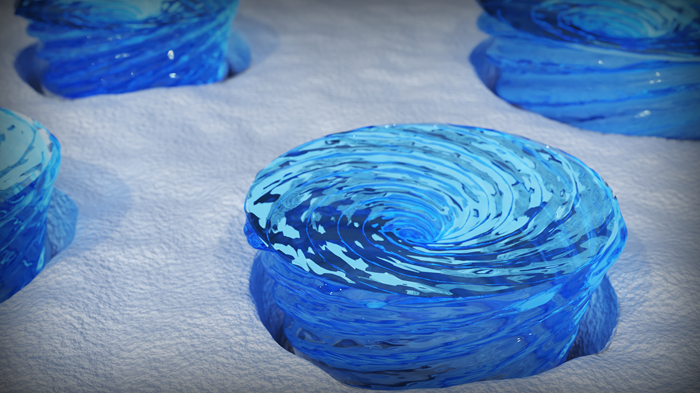Prof. Catherine Dubourdieu (HZB and FU Berlin) and colleagues from the CEMES-CNRS in Toulouse, the University of Picardie in Amiens, and the Jozef Stefan Institute in Ljubljana have published a study in Nature Communications that thoroughly investigates a particularly interesting class of nanoislands on silicon and explores their suitability for electrical manipulation.
 Artistic representation of the center down-convergent polarization field. It results from the compression of the polarization flux by the sidewalls of the nanoislands. The texture in each nanoisland resembles a swirling vortex of liquid flowing into a narrowing funnel. Image Credit: Laura Canil /Helmholtz-Zentrum Berlin
Artistic representation of the center down-convergent polarization field. It results from the compression of the polarization flux by the sidewalls of the nanoislands. The texture in each nanoisland resembles a swirling vortex of liquid flowing into a narrowing funnel. Image Credit: Laura Canil /Helmholtz-Zentrum Berlin
Nanostructures with unique electromagnetic patterns have potential uses in nanoelectronics and future information technologies. However, it is extremely difficult to manage those patterns. HZB researchers have now investigated a unique class of nanoislands on silicon with intriguing chiral, whirling polar patterns that can be stabilized and even reversibly altered by an external electric field.
Ferroelectrics at the nanoscale display various polar and occasionally swirling (chiral) electromagnetic patterns, which reflect intriguing physics and hold promise for future nanoelectronics. Consider ultra-high-density data storage or incredibly energy-efficient field-effect transistors. However, the durability of these topological textures and how they might be manipulated and guided by an external electrical or optical input have proven to be a source of contention.
Nanoislands on Silicon
We have produced BaTiO3 nanostructures that form tiny islands on a silicon substrate.
Catherine Dubourdieu, Professor, Helmholtz-Zentrum Berlin für Materialien und Energie
The nano-islands are trapezoidal, with dimensions of 30–60 nm (on top), and have stable polarization domains.
By fine tuning the first step of the silicon wafer passivation, we could induce the nucleation of these nanoislands.
Dong-Jik Kim, Scientist, Helmholtz-Zentrum Berlin
Domain Patterns Studied by PFM
An electric field can reversibly transition between these domains. Vertical and lateral piezoresponse force microscopy was used to investigate the domain patterns.
Both the PFM measurement data and the phase field modelling indicate a centred, downward convergent polarisation, which fits perfectly well with the information from scanning transmission electron microscopy (STEM).
Ibukun Olaniyan, Ph.D. Student, Helmholtz-Zentrum Berlin für Materialien und Energie
Reversible Switching
The scientists identified a swirling component around the nanoisland axis that generates chirality.
“The texture resembles a swirling vortex of liquid flowing into a narrowing funnel. The center down-converging nanodomains can be reversibly switched to center up-diverging nanodomains by an external electric field,” explained Dubourdieu.
“In this work, we have shown that chiral topological textures can be stabilized by shaping nanostructures in an appropriate way,” concluded Dubourdieu.
The ability to produce and electrically alter chiral, swirling, polar patterns in BaTiO3 nanostructures shows great promise for future applications.
This research was partially funded by the ERC Advanced Grant LUCIOLE (101098216).
Journal Reference:
Olaniyan, I., et al. (2024) Switchable topological polar states in epitaxial BaTiO3 nanoislands on silicon. Nature Communications. doi.org/10.1038/s41467-024-54285-z